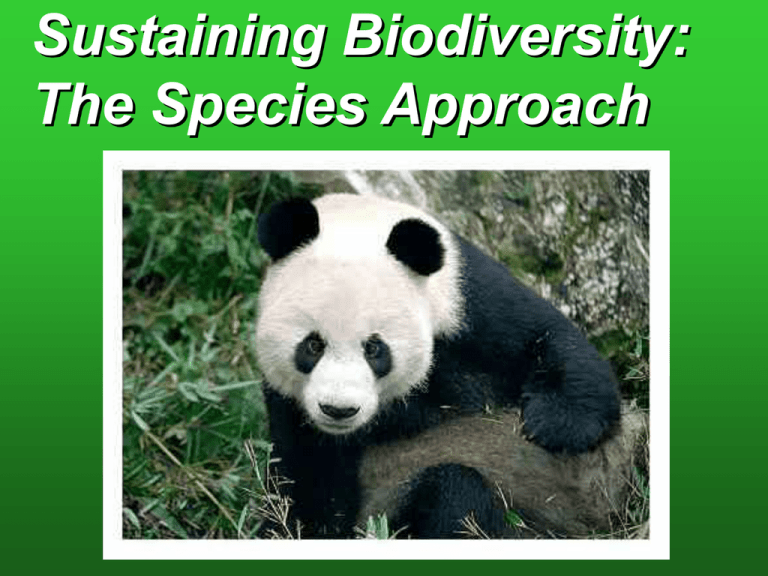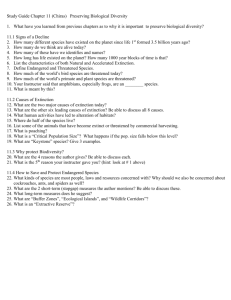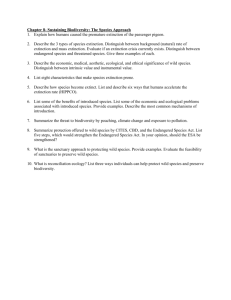Species Restoration
advertisement

Sustaining Biodiversity: The Species Approach Key Concepts Human effects on extinction rates Biodiversity and extinction How human activities endanger wildlife Preventing extinction Reconciliation ecology Types of Species Extinction Local extinction Ecological extinction Biological extinction Extinct Species Passenger pigeon Great auk Dodo Dusky seaside sparrow Aepyornis (Madagascar) Endangered and Threatened Species Endangered species Threatened (vulnerable) species The red list Florida manatee Northern spotted owl (threatened) Gray wolf Florida panther © 2004 Brooks/Cole-Thomson Learning Bannerman's turaco (Africa) Grizzly bear (threatened) Kirtland's warbler White top pitcher plant Arabian oryx (Middle East) African elephant (Africa) Mojave desert tortoise (threatened) Swallowtail butterfly Humpback chub Golden lion tamarin (Brazil) Siberian tiger (Siberia) West Virginia Giant panda spring salamander (China) Mountain gorilla (Africa) Pine barrens tree frog (male) Whooping crane Knowlton cactus Swamp pink Hawksbill sea turtle Blue whale El Segundo blue butterfly Florida manatee Northern spotted owl (threatened) Gray wolf Florida panther Devil's hole pupfish Snow leopard (Central Asia) Symphonia (Madagascar) Black-footed ferret Ghost bat (Australia) California condor Black lace cactus Black rhinoceros (Africa) Bannerman's turaco (Africa) Utah prairie dog (threatened) Oahu tree snail 34% (51% of freshwater species) Fish 24% Mammals 20% Reptiles Plants Birds 14% 12% Extinction Rates Background (natural) rate of extinction Mass extinction Extinction spasm Characteri stics of Extinction Prone Species Characteristic Examples Low reproductive rate (K-strategist) Blue whale, giant panda, rhinoceros Specialized niche Blue whale, giant panda, Everglades kite Narrow distribution Many island species, elephant seal, desert pupfish Feeds at high trophic level Bengal tiger, bald eagle, grizzly bear Fixed migratory patterns Blue whale, whooping crane, sea turtles Rare Many island species, African violet, some orchids Commercially valuable Snow leopard, tiger, elephant, rhinoceros, rare plants and birds Large territories California condor, grizzly bear, Florida panther Problems with estimating extinction rates Extinction not easily documented over time Many species remain unidentified Little is known about most identified species Estimating Extinction Rates Species-area relationships Population viability analysis (PVA) Minimum viable population (MVP) Minimum dynamic area (MDA) Causes of Depletion of Wild Species Human population growth Increasing per capita resource use Endangered centers of biodiversity Environmental destruction Spread of opportunistic species Causes of Premature Extinction of Wild Species Habitat loss Overfishing Pollution Habitat degradation and fragmentation Climate change Commercial hunting and poaching Introducing nonnative species Predator and pest control Secondary Causes •Population growth •Rising resource use •No environmental accounting •Poverty Basic Causes Sale of exotic pets and decorative plants Why are wild species Important? Rebuilding biodiversity is slow Instrumental value Genetic information Eco-tourism Ecological value Intrinsic value Range in 1700 Range today (about 2,400 left) Black Rhino Probable range 1600 Range today (300,000 left) African Elephant Former range Range today (34,000–54,000 left) Asian or Indian Elephant Range 100 years ago Range today (about 2,300 left) Indian Tiger Habitat Loss and Degradation Greatest threat to species “HIPPO” Habitat destruction Invasive species Population (humans) growth Pollution Overharvesting Threats from Exotic Species Arrival Roles of nonnative species Prevention Sea lamprey (attached to lake trout) Argentina fire ant Brown tree snake Eurasian muffle Common pigeon (Rock dove) Formosan termite Zebra mussel Asian long-horned beetle Asian tiger mosquito Gypsy moth larvae Accidentally introduced Species Purple loosestrife Marine toad European starling African honeybee (“Killer bee”) Water hyacinth Japanese beetle Nutria Salt cedar (Tamarisk) Hydrilla Deliberately introduced Species European wild boar (Feral pig) Cerulean warbler Florida scrub jay Sprague’s pipit Bichnell’s thrush California gnatcatcher Kirtland’s warbler Blacked-capped vireo Golden-cheeked warbler Henslow’s sparrow Bachman’s warbler Kudzu 1918 2000 Other Extinction Threats Hunting and Poaching Predators and Pest Control Exotic Pets and Decorative Plants Climate Change and Pollution Protecting Wild Species: The Research and Legal Approaches International Treaties: CITES and CBD U.S. National Laws: Lacey Act Endangered Species Act Habitat recovery plans Endangered Species Act (ESA) Private versus public poverty rights Win-win compromises Weaken or strengthen the Act? Protecting Wild Species: The Sanctuary Approach Wildlife refuges and protected areas Gene banks, botanical gardens, and farms Zoos and Aquariums Reconciliation Ecology Establishing and maintaining new habitats Being good neighbors to wildlife Reward voluntary conservation efforts 2 4 3 5 Top Six Hot Spots 6 1 Hawaii 2 San Francisco Bay area 3 Southern Appalachians 4 Death Valley 5 Southern California 6 Florida Panhandle Concentration of rare species 1 Low Moderate High North American-South American flyways European-African flyways Asian flyways What can an individual do? Do not buy furs, ivory products, and other materials made from endangered or threatened animal species. Do not buy wood and paper products produced by cutting remaining old-growth forests in the tropics. Do not buy birds, snakes, turtles, tropical fish, and other animals that are taken from the wild. Do not buy orchids, cacti, and other plants that are taken from the wild.







